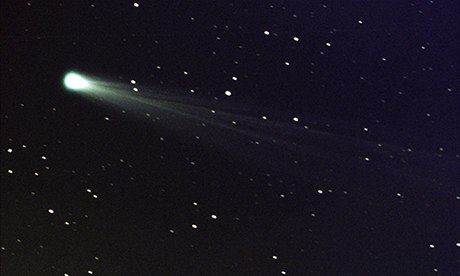
Comet Ison seen from a Nasa telescope on 19 November. Photograph: Aaron Kingery/Nasa/EPA
Comet could become visible from Earth in next week or two if it survives passing 730,000 miles from sun's surface on Thursday.
A comet that left the outer edge of the solar system more than 5.5 million years ago will pass close by the sun on Thursday, and could become visible from Earth in the next week or two if it survives.
A comet that left the outer edge of the solar system more than 5.5 million years ago will pass close by the sun on Thursday, and could become visible from Earth in the next week or two if it survives.
Comet Ison is due to pass 730,000 miles from the surface of the sun at 6.37pm GMT on Thursday.
At that distance, the comet will reach temperatures approaching 2,760C (5,000F), hot enough to vaporise not just ices in the comet's body but dust and rock as well.
Professor Tim O'Brien, associate director of the Jodrell Bank Observatory, told the BBC: "It's like throwing a snowball into fire. It's going to be tough for it to survive. But luckily it's a big object and it moves fast, so it won't spend too much time close to the sun. There is a lot of uncertainty."
Donald Yeomans, of Nasa's near-Earth object programme, said in an interview posted on space agency's website: "There are three possibilities when this comet rounds the sun.
"It could be tough enough to survive the passage of the sun and be a fairly bright, naked-eye object," he said. Alternatively, the sun's gravity could rip Ison apart, creating several big chunks, or the comet could break up into a cloud of dust.
Carey Lisse, senior research scientist at Johns Hopkins applied physics laboratory, said: "This comet is giving us quite a ride. It's going to be hard to predict exactly what's going on. As a betting man, I think it's not going to survive solar passage."
Scientists estimate that Ison needs to be about 200 metres in diameter to survive its close encounter with the sun. The most recent measurements indicate the comet is more than twice that size, and perhaps as big as 1,200 metres across. When it zips around the sun it will be moving at about 217 miles per second.
The comet was discovered last year by two amateur astronomers using Russia's International Scientific Optical Network, or Ison. It was extraordinarily bright at the time, considering its great distance beyond Jupiter's orbit, raising the prospect of a truly cosmic spectacle as it approached the sun.
Heat from the sun causes ice in a comet's body to vaporise, creating distinctive bright tails and fuzzy-looking glowing bodies. The closer thatcomets come to the sun, the brighter they shine, depending on how much ice they contain.
Comets are believed to be frozen remains left over from the formation of the solar system 4.5 billion years ago. The family of comets that Ison is from resides in the Oort cloud, located about 10,000 times farther away from the sun than Earth, halfway to the next star.
Occasionally a comet is gravitationally nudged out of the cloud by a passing star and into a flight path that millions of years later brings it into the inner solar system. Computer models show Ison is a first-time visitor.
"You need comets in order to build the planets and this comet has been in deep freeze in the Oort cloud for the last 4.5 billion years," Lisse said. "Comet Ison is a relic. It's a dinosaur bone of solar system formation."
Oort cloud comets have passed by Earth before, and sun-grazing comets are common. Comet Ison, however, is unique. "We have never seen a comet like this, a comet that is both dynamically new from the Oort cloud and in a sun-grazing orbit," said Karl Battams, an astrophysicist with the Naval Research Laboratory in Washington.
"It has been behaving strangely," Battams said, noting recent flares and changes in brightness that could be signs the comet is fragmenting. Regardless of what happens, "it's already been a huge victory for science," he said.
No comments:
Post a Comment